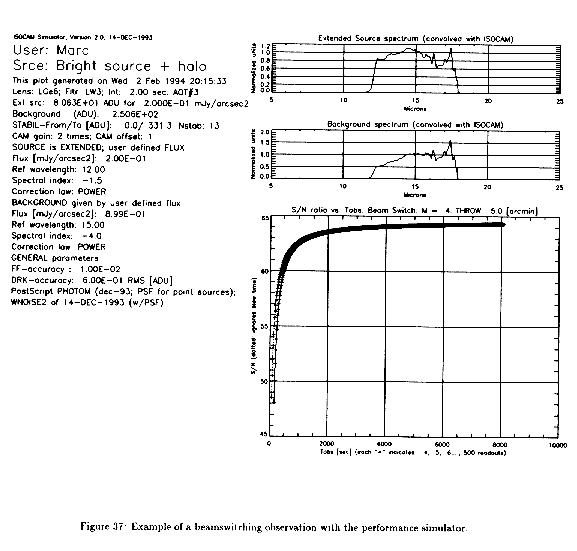Micro-scan observation




Next: Beamswitching observation
Up: Worked examples
Previous: Single pointing observations
For this example, we have chosen an extreme case where we want to
observe a faint extended source undetected by IRAS at 12  m. We
will observe it through the LW3 filter and request that the noise level
be 0.4
m. We
will observe it through the LW3 filter and request that the noise level
be 0.4  Jy/''
Jy/'' at 12
at 12  m. The background in that case is
estimated at 630
m. The background in that case is
estimated at 630  Jy/''
Jy/'' . In this extreme situation of a
background dominated observation, a micro-scan (CAM01) is the only way
to achieve our goal.
. In this extreme situation of a
background dominated observation, a micro-scan (CAM01) is the only way
to achieve our goal.
As before, the pixel field of view will be 6'', but this time we will
integrate longer: 10 s per frame.
In a raster mode we have to specify the step (in units of the pixel
field of view) as well as the number of steps in each direction. Here we
have chosen to build a 5 5 map, with a step of 6'' (corresponding to 1 pixel with the selected PFOV) in each
direction.
5 map, with a step of 6'' (corresponding to 1 pixel with the selected PFOV) in each
direction.
Figure  shows the result of this computation. The
difference between the upper and lower curve is now that the upper one
does not take into account the slew time between each position of the
raster map. The lower curve shows that a S/N of 1 can be achieved in
2000 s. Note that the area covered with this accuracy is only of
(180
shows the result of this computation. The
difference between the upper and lower curve is now that the upper one
does not take into account the slew time between each position of the
raster map. The lower curve shows that a S/N of 1 can be achieved in
2000 s. Note that the area covered with this accuracy is only of
(180 180) arsec
180) arsec . With this observing time, a total of 7
readouts will be performed on each map position.
. With this observing time, a total of 7
readouts will be performed on each map position.
Note that 180 s for pointing have to be added to that result to give
the total observing time.

Figure: Example of a beamswitching observation with the performance
simulator.
ISOCAM Observer's Manual - V1.0
Tue Oct 31 12:06:23 MET 1995
 m. We
will observe it through the LW3 filter and request that the noise level
be 0.4
m. We
will observe it through the LW3 filter and request that the noise level
be 0.4  Jy/''
Jy/'' at 12
at 12  m. The background in that case is
estimated at 630
m. The background in that case is
estimated at 630  Jy/''
Jy/'' . In this extreme situation of a
background dominated observation, a micro-scan (CAM01) is the only way
to achieve our goal.
. In this extreme situation of a
background dominated observation, a micro-scan (CAM01) is the only way
to achieve our goal.




 5 map, with a step of 6'' (corresponding to 1 pixel with the selected PFOV) in each
direction.
5 map, with a step of 6'' (corresponding to 1 pixel with the selected PFOV) in each
direction.

